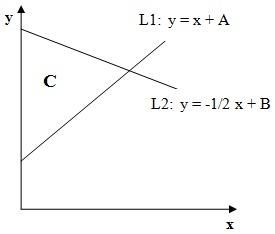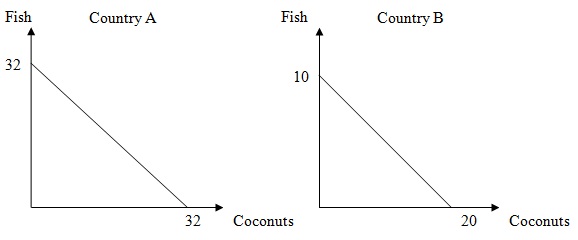Binary Choice:
Problem 1) The study of the determining factors of the inflation rate would be studied primarily in:
a. Macroeconomics.
b. Microeconomics.
Problem 2) Increased unemployment benefits during a recession can help sustain aggregate demand. The previous statement is
a. normative
b. positive
Problem 3) Oranges and apples are substitutes and a storm in Florida ruined the production of oranges. These changes in the market for oranges will result in a movement along the demand curve for apples.
a. True
b. False
Problem 4) Will a $200 sales commission received by a stockbroker when she sells 300 shares of stock in a domestic firm increase this year’s GDP? Assume the stock was sold during this year.
a. Yes.
b. No.
Problem 5) The real GDP of a country in 2004 and 2005 are, respectively, $40 billion and $50 billion. The growth rate of this country is:
a. 20%
b. 25%
Problem 6) Suppose the demand curve is steeper than the supply curve (that is, the absolute value of the slope of the demand curve is greater than the absolute value of the slope of the supply curve). When this is the case, producer surplus is always greater than consumer surplus.
a. True
b. False
Problem 7) John gets a wage of $1,000 from his job, bond interest of $500 from the financial market, but pays a tax of $300. Thus, he spends $1,200. John’s income is:
a. $1,500
b. $1,200
Problem 8) Daniel is living in the United States, but he owns a company based in Japan. Is the profit of this company included in the GDP of the United States?
a. Yes
b. No
Problem 9) Although Tom would prefer to have a full time job, he accepted a part time job, because he could not find a full time job. Tom would be classified as
a. employed
b. unemployed
Multiple Choice
Note: All graphs are not drawn to scale
Problem 10) Suppose the demand curve is: P=100-1/2Q. The supply curve is: P=10+1/2Q. What level of excise tax ought to be imposed, such that the quantity traded will be 10?
a. $60
b. $70
c. $80
d. $90
Problem 11) Use the following information to answer the question:
|
|
Apples
|
Oranges
|
|
Mick
|
24
|
16
|
|
Paddy
|
16
|
16
|
The accompanying table shows the maximum amounts of apples and oranges that Mick and Paddy can produce if they only produce one good. Mick produces and consumes 13 apples and 5 oranges, and Paddy produces and consumes 9 apples and 5 oranges. Now they decide to engage in trade. Which of the following statements is INCORRECT?
a. For both to become better off, each should specialize in the production of some good. However, since Paddy is equally productive in both goods, it doesn't matter which good each specializes in.
b. For maximum total production of the two goods, Mick and Paddy should each specialize completely in the production of the good for which he has a comparative advantage.
c. After trade it is possible for Mick to consume 14 apples and 10 oranges, and for Paddy to consume 10 apples and 6 oranges.
d. For each individual, the consumption point after trade can lie outside that individual's production possibility frontier.
Problem 12) A point lying inside (under) the production possibility frontier indicates that:
a. the economy is saving money.
b. there are no associated opportunity costs.
c. the economy is technically efficient.
d. more output could be produced with existing resources.
Problem 13) The demand for cable TV is given by the equation Q = 1200 - 10P where Q represents quantity and P represents price. At what price will there be 900 cable subscribers?
a. $20
b. $30
c. $200
d. $300
Problem 14) The following is information about Wiscosland.
Population (16 years or older) 400
Number of employed workers with full time job 150
Number of employed workers with part time job 50
Number of unemployed workers 50
What is the unemployment rate of Wiscosland?
a. (50/400)*100
b. (100/400)*100
c. (250/400)*100
d. (50/250)*100
Use the figure below to answer the following question.

Problem 15) What is the x-intercept of L2?
a. 2B
b. (1/2) B
c. B
d. B – (1/2)
Use the table below to answer the following question
|
Used Econ Textbooks 2006
|
|
price
|
# demanded
|
# supplied
|
|
30
|
1000
|
100
|
|
40
|
800
|
300
|
|
50
|
600
|
500
|
|
60
|
400
|
700
|
|
70
|
200
|
900
|
Problem 16) What is a possible equilibrium price for used econ textbooks?
a. $35
b. $44
c. $52
d. $60
Problem 17) Consider a situation where there are 2 countries, A and B. They both can produce either fish or coconuts. Their respective PPFs are shown in the following graph.

Which of the following statements is TRUE?
a. Country A should sell fish in exchange for coconuts.
b. Country A should sell coconuts in exchange for fish.
c. Country B has a comparative advantage in fish production.
d. Both B) and C) are true.
Problem 18) Which of the following does not contribute toward improvement in labor productivity?
a. The business cycle.
b. Physical capital.
c. Human capital.
d. Technology.
Problem 19) The nominal GDP in 2005 is $150 and the value of the GDP deflator, when real GDP is expressed in 2000 dollars, is 5. What is the value of real GDP in 2005, in 2000 dollars?
a. 50
b. 30
c. 3.33
d. 3
Problem 20) The following table shows the PPF for a bakery that can produce both bread and pies.
|
Loaves of Bread
|
Pies
|
|
20
|
0
|
|
15
|
3
|
|
10
|
6
|
|
5
|
9
|
|
0
|
12
|
The opportunity cost of two loaves of bread is
a. 3/5 pies
b. 5/6 pies
c. 6/5 pies
d 5/3 pies
Problem 21) How will a Florida hurricane that destroys orange groves affect the market for apple juice?
a. Supply and demand for apple juice increase.
b. Supply of apple juice is constant and demand for apple juice increases.
c. Supply of apple juice increases and demand for apple juice decreases.
d. Supply of apple juice increases and demand for apple juice is constant.
Problem 22) The production possibilities frontier is bowed-out from the origin, because:
a. resources are not equally suited for the production of both goods.
b. economic growth leads to inefficiency.
c. resources are inefficiently used.
d. none of the above are true.
Problem 23) The unemployment caused by a recession is
a. natural unemployment.
b. frictional unemployment.
c. structural unemployment.
d. cyclical unemployment.
Use the following information for the next two questions. The domestic demand curve is: P=50-2Q and the domestic supply curve is: P=10+1/2Q. Assume this country is a small closed economy.
Problem 24) Suppose the government imposes a price ceiling at $19. Which of the following is the new quantity supplied?
a. 15.5
b. 16
c. 17
d. 18
Problem 25) Suppose the world price is $20 and this country opens its economy to trade. What will be the value of consumer surplus for this country when it becomes an open economy?
a. $450
b. $900
c. $325
d. $225
Problem 26) The economy of Wiscosland produces two goods: milk and cheese. In 2004, 100 gallons of milk was produced; the market price of milk was $10 per gallon. 50 gallons of milk were used to produce 10 pounds of cheese and 50 gallons of milk were sold to household consumers. Cheese makers sold cheese to the grocery store chain, GoodCheese, at a price of $100 per pound. The household consumer could only buy cheese from GoodCheese at a price of $110 per pound at the grocery. What was the GDP of Wiscosland in 2004?
a. $1,500
b. $1,600
c. $2,000
d. $2,100
Problem 27) The nominal GDP in a country was 15% higher in 2004 than 2003. What does this imply?
a. The country's production grew by 15% from 2003 to 2004.
b. The monetary value of the country's production grew by 15% from 2003 to 2004.
c. Goods cost 15% more in 2004 than 2003.
d. Each individual is 15% wealthier in 2004 than 2003.
Problem 28) Using a base year of 2000, the CPI was 150 in 2004 and 165 in 2005. Calculate the inflation rate from 2004 to 2005.
a. 65%
b. 20%
c. 10%
d 15%
Problem 29) In a country, people, on average, consume 4 apples, 8 bananas, and 10 oranges. Apples cost $0.50 in 2004 and $0.75 in 2006. Bananas cost $0.25 in 2004 and their price doubled between 2004 and 2006. Oranges cost $0.60 in 2004 and their price rose at the same rate as apples between 2004 and 2006. What is the value of the CPI in 2006, using 2004 as the base year?
a. 150
b. 160
c. 175
d. 200